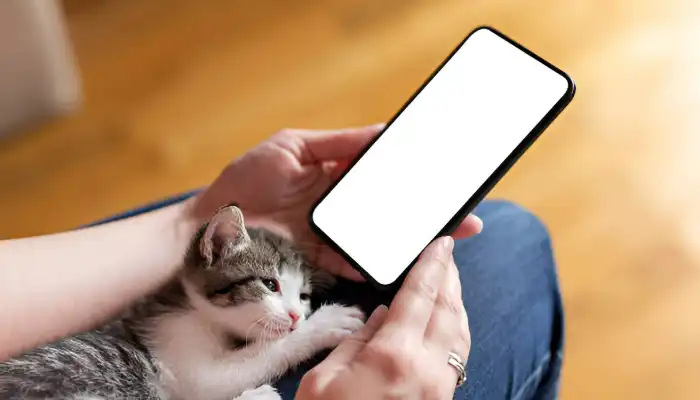Human to cat translator tools that claim to translate the human language to cat have become popular among cat lovers wanting to communicate with their pets more effectively. Apps and devices that claim to translate cat sounds and even convert human voice to ‘cat language’ exist.
The concept of a feline sounds translator is interesting, but its fidelity is undetermined. Since cats communicate using sounds, body movement, and scent, translating would be very difficult. This essay analyzes how a cat translator cat to human works, whether or not they are effective, and assesses the claim that they help people bond with their pets

Human to Cat Translator: A Quick Overview
Cats have several innovative methods they use to speak, such as meowing, moving, and even scenting. Most cat owners often find themselves questioning whether machines can help ease the barriers found between cats and people.
This brings us to the human to cat translator. The devices are said to assist in translating interpretable cat noises and even changing human words to a cat-friendly dialect.
Human Cat Translators Function
The human to cat translators include the following features:
- Sound Recognition: Some applications match the cat’s meows with potential meanings and frequencies that suit preexisting definitions.
- Artificial Intelligence-Machine Learning: More sophisticated tools adjust what is calculated to be accurate in the future through artificial intelligence.
- Sound Boards: Many translators do not seek actual translation, but rather depend on previously stored databases.
Types of Human-Cat Translators
These devices can be accounted for as some of the tools that exist today:
- Mobile Apps: The applications available on cats’ smartphones allow pet owners to tape-record their cat’s voice and in turn receive a probable definition.
- Wearable Devices: Some experimental devices are created to watch a cat’s sounds and movements.
- Interactive Toys: Some devices are programmed to capture the attention of a cat by pretending to speak as a kitten.
Your cat might love to play with you, but a human to cat translator is just an entertaining gimmick. Knowing how to communicate with your cat in its language naturally is what makes pet-parent relationships fulfilling.

Do Human to Cat Translators Work?
Cat owners particularly wish they were able to understand their feline companions much better. The concept of a human to cat translator is reasonable but incredibly perplexing.
It prompts us to ask, Do these tools genuinely work? Some apps and gadgets claim to decipher cat sounds, yet their claims are highly disputable for reasons of precision and scientific proof of their claims.
Challenges in Translating cat translator cat to human. The basis for cats not being able to be accurately translated stems from the fact that they communicate in a diverse manner that differs from one feline to another. Here are some of the more unique hurdles:
- Cats use vocalization selectively: In contrast to canines, feline creatures do not use sounds as their primary means of interspecies communication.
- Differences in breeds and personalities: Certain breeds such as the Siamese tend to be particularly talkative while other cats barely meow at all.
- Everything is contextual: Depending on the tone and situation, the same sentence can change meanings completely.
Scientific Studies on Cat Communication Studies focusing on the communication patterns of cats reveal that their main channel of transmitting information to humans is through:
- Meows: Usually employed for grabbing the attention of a person rather than for communicating amongst fellow cats.
- Purring: This is usually linked with satisfaction, but can also accompany relief from pain.
- Chirps and Trills: These are all friendly sounds that are often directed towards known humans for greetings.
With a cat translator cat to human translator cat tool, you may engage your pet better, but it won’t understand meowing because there are no fixed definitions for cat sounds.
While it may be amusing to use a human to cat translator, cat owners ought to utilize their onus on their cat’s body language and behavior instead of relying on an app that claims to translate their cat’s speech.

Best Human to Cat Translator Apps & Devices
With the growing curiosity about devices and applications relating to pet communication, many have emerged declaring that they can serve as a human to cat translator. The functions of these tools differ significantly, hence the importance of understanding what they provide beforehand.
Insights into English to cat translator cat to human translation apps’ features and functions In this section, we present insights into a summary of the differentiating features of some popular cat translator app, which include features, ratings, and effectiveness.
| App Name | Features | User Ratings | Effectiveness |
|---|---|---|---|
| MeowTalk | AI-based identification of cat sounds | 4.2/5 | Moderate |
| Human-to-Cat Translator | Interactive with pre-recorded cat sounds | 4.0/5 | Low |
| Cat Communicator | Different meows for different moods | 3.8/5 | Low |
Judging Prospects of Cat Apps
Pros:
- Novelty and interactive features for pet owners.
- Focuses the owner’s attention towards their cat’s sounds.
- Help cat owners create bonding moments.
Cons:
- Not backed by any scientific verification.
- The sound may be completely different from actual cat speech.
- The app is highly distracting, along with the entertainment value.
The Bottom Line While a human to cat translator may provide a fun way to bond with your feline friend, knowing how to interpret and understand cat behavior and communication is far more useful.
The Ways Cats Communicate
Human to cat meow translator transmit messages, cats utilize body movements, vocal sounds, and scent signals. Unlike a person, a cat would never use words because it can express its feelings, requirements, and alerts via several different methods.
Cat Sounds – What Do They Mean?
Felines are capable of making meows, growls, whines, purr sounds, and other noises about different creatures, including their owners. Here are the most heard cat sounds and their meanings:
| Cat Sound | Meaning |
|---|---|
| Meow | General communication, often directed at humans |
| Purr | Contentment, relaxation, or sometimes pain relief |
| Chirp/Trill | Friendly greeting or request for attention |
| Hiss/Growl | Warning or defensive behavior |
| Yowl | Mating call, distress, or territorial alert |
Despite the reasons behind different sounds being made by cats, where this animal lives, what breed it belongs to and its character does have an overall impact on the sounds a feline makes.
Body Language – Silent Communication
Human to cat translator: Another method through which cats communicate is through body movements, and here are some of the main signs:
- Tail Position: A friendly cat will keep its tail upright while fearful cats will puff theirs up.
- Ears: When a cat’s ears point forward, it indicates that the feline is curious, but if they are flattened, it means aggression or discomfort.
- Eyes: Slow blinking might indicate trust, while pupils that widen can suggest fear or excitement.
- Posture: Alertness and defensiveness is indicated by an arched back while a cat sitting comfortably demonstrates a relaxed posture.
Cats and Their Senses: Scent & Touch
Cats use scent to establish their space as well as their human’s space. These approaches consist of:
- Marking with Rubbing on Various Objects or People: Rubs allow them to mark their scent and provide smoothness at the same time.
- Scratching on Various Surfaces: It is not only to mark territory and sharpen their claws but also for a projection of scent.
- Grooming Closer People: This is gently washing another person, which indicates love and companionship.
By using these forms of communication, pet owners can understand their pets better and in an enhanced manner. Less reliance on a human to cat translator app and a deeper understanding of how a cat naturally behaves promotes a more hands-on approach.
Can You Talk to Your Cat?
The possibility of talking with their cats is a question that arises for cat owners. Despite a cat’s inability to process words, the sounds they make, their tone, and accompanying actions can be helpful for ease of understanding.
Best Way to Communicate With Your Cat
Consistency in tone and the voice being used proves to be more effective than the actual words spoken. To ease the exchange of information:
- A Gentle Soothing Voice: Cats love having a calm voice directed at them rather than angry or loud people.
- Pairing Actions with Words: Before mealtime, saying ‘food’ helps them learn to associate the word with eating time.
- Watch Them Closely: A cat that looks at you and blinks slowly may be trying to show you they trust you, so try doing the same back.
Talking to Your Cat with Body and Voice
These combinations usually don’t exist in human speech, but that doesn’t mean they should be avoided:
- Frequent Repetition: Over time, cats can distinguish frequently used phrases.
- Verbal Directions: You can use issued directions to draw their focus to what you want.
- Compliments: Showing affection or giving treats for good behaviors encourages further desirable actions.
Easy Ways to Train Your Cat
Unlike dogs, cats do not tend to follow orders, but they can be taught with some encouragement:
- Training With Sounds: Associating a sound with an action helps develop a response to the sound.
- Name Cues: Repeating names, especially in a friendly voice, makes the name more recognizable.
- Verbal Commands: With positive reinforcement, commands like “come” and “sit” can be introduced.
Using nature-focused methods to interact with your feline friend is more effective than a simple human to cat translator.
If you’re wondering how to speak cat translator apps may offer some guidance, but learning to interpret body language and vocal ranges will create a deeper bond with your pet.
Other Ways to Talk to Your Cat
While the human to cat translator is appealing to many pet owners, there are better methods of comprehending cat communication instead of a pet translator. Monitoring your cat’s activity and actions can assist in further comprehension of their needs and feelings.
Observing Your Cat’s Natural Behavior
Instead of depending on a device cat language translator, you can understand a cat’s mood by observing the way it uses different situations:
- Playfulness: When your feline leaps and bounds about out of nowhere, this is an indication they are sociable.
- Avoidance: The cat is likely feeling tense or uncomfortable if it is hiding from exposure.
- Tail Flicking: Irritation is indicated by fast flicking, swishing the tail slowly shows they want to explore.
How to Praise Your Cat the Right Way
Cats respond better to positive stimuli rather than negative ones. Some tips are:
- Rewarding Good Behavior with Treats: Giving them snacks or petting them when they perform actions like responding to their name.
- Clicker Training: Giving verbal cues to encourage positive actions.
- Routines: Following set schedules for meals, exercise, and bedtime, comforting for cats.
Understanding the Main Cat Sounds and Their Meaning
Instead of a cat translator cat to human, cats can express their feelings more freely without restrictions if their owners comprehend basic sounds like vocalizations such as meowing, chirping, and quiet buzzing during different situations.
Despite the intriguing nature of a human to cat translator, the most effective way of interacting with your feline pet is through blending patience with careful listening. This blend fosters a relationship of deeper trust and understanding.
Options Apart From Cat Translators
Numerous pet owners are attracted to human to cat translator applications and gadgets designed to translate cat sounds, but there exist more accurate methods to discern the communication attempts of your kitty. One’s cat’s behavior and vocalizations capture their needs and feelings in a more revealing manner.
Observing Cat Behavior
Cats’ sounds are accompanied by body language and smell. Comprehending their emotions and reactions is usually easy once these comprehension signals have been understood without the need to rely on digital devices.
Tail Positions: Usually, a tail held upright means one is happy. However, a tail that is held straight can also show annoyance.
Ears & Eyes: Ears held forward suggest interest whereas ears held back are a sign of aggression or fear. Blinking slowly is a form of showing trust.
Vocalizations: A brief meow can be used as a form of greeting. While a long drawn-out meow can be used as a sign of demand or distress.
Cat Training Made Easy with Rewards
Positive cat training can improve how you pass messages across to your cat. Cats appreciate rewards and form a habit that increases the likelihood of learning desired behaviors.
- Instead of incessant meowing, calm and quiet vocal phrases should be rewarded.
- Rewarding your cat with a treat and saying nice things when they listen will turn into a sign of obedience to your command.
- Create a set schedule for when your cat can expect to be fed, played with, or rested.
Common Cat Sounds and Their Meanings
You might not want to use a human to cat translator because they are never accurate, but familiarizing yourself with some common cat sounds can help you understand them better. Here’s a chart that summarizes the meanings of feline vocalizations:
| Sound of Cat | Meaning Interpretation |
|---|---|
| Short Meow | Greeting or Request |
| Purring | Happiness or self-reassurance |
| Chirping | Joy or talking to a target |
| Growling | Threat or Anxiety |
| Hissing | Offense or discomfort |
Focusing on these natural components of speech enables you to enhance your relationship with your cat without relying on a human to cat translator. The time you devote to understanding your cat’s behavior will surely pay off as it leads to a stronger bond.
FAQs About Cat Translators for Humans
Pet parents often have concerns about such translation devices and their effectiveness. This section highlights the most popular queries we receive about them.
1. Can Cats Understand What We Say?
Cats customarily learn a limited vocabulary, such as their names and words relating to treats. While, for the most part, cats don’t pay attention to what is said, they can recognize a few words that are oftentimes accompanied by rewards.
2. Can My Cat Respond to a Cat Translator?
Although a human to cat translator can produce sounds typical in cats, no scientific research evidence supports the claim that such sounds are deemed communication in any way.
Your cat might respond in curiosity, but they are not “talking” back in a genuine way.
3. Is My Feline Friend Safe with These Apps?
Most of the human to cat translator apps are user-friendly, but it is important to pay close attention to your cat’s behavior.
Some cats might be curious and find the sounds interesting, while others might become stressed and agitated. Always observe your pet whenever such tools are used.
With patience and keen observation, you can understand how your cat communicates. Apps can be entertaining, but they should never replace real-life interactions and the learning of your cat’s special signals.
Conclusion
Human to cat translator may sound engaging for closing the communication gap with your furry friend, but there are better methods of achieving that. Cats frequently interact using sounds, movements, and even smell.
Although apps and devices may seem useful, they do not serve any scientific purpose. By learning what your cat is trying to tell you and being patient, you can strengthen the bond. A cat speaks to its owner best by merging interaction with trust.
